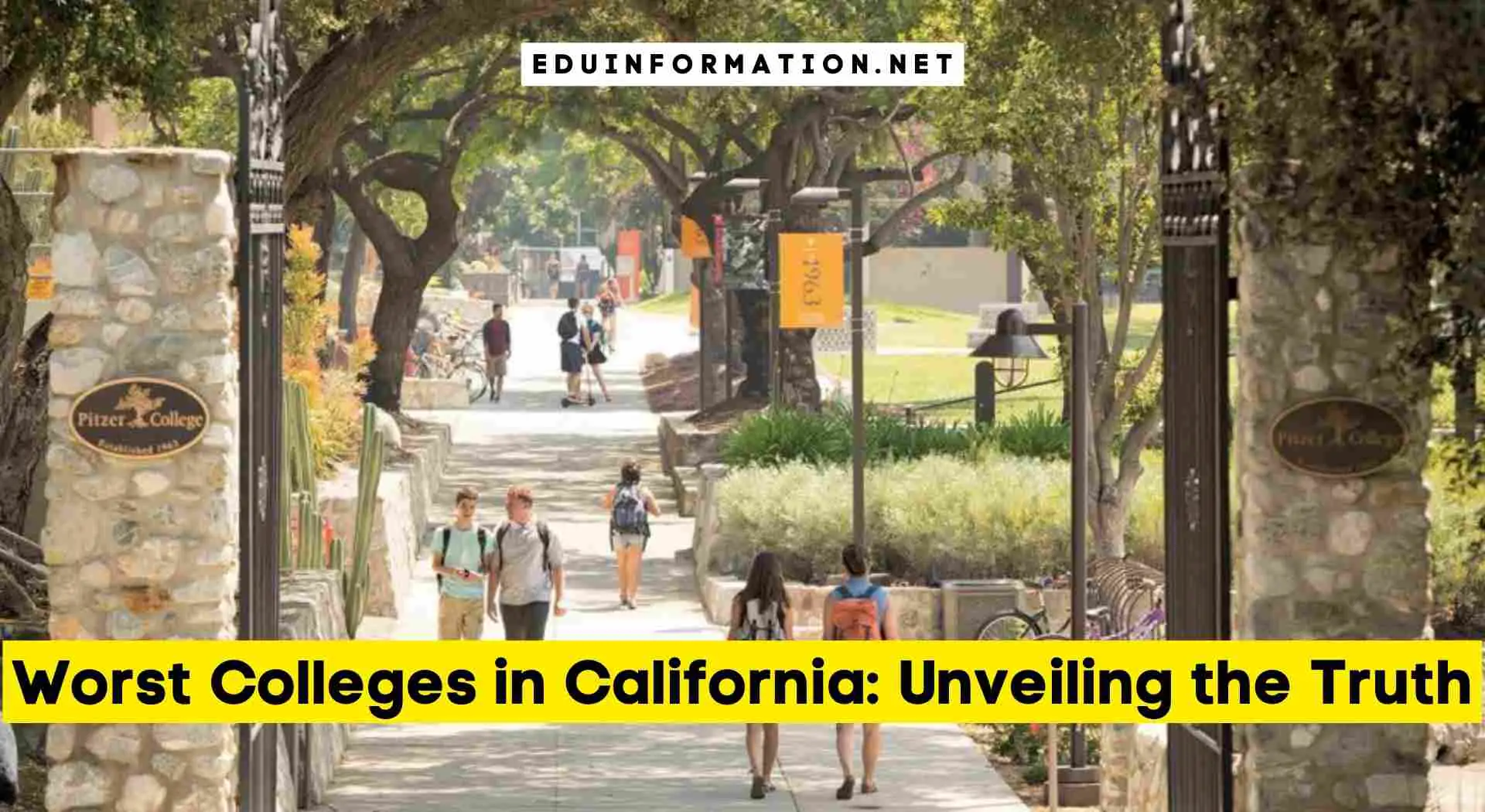California has some colleges that are considered the worst due to various factors such as low graduation rates, high student loan default rates, and poor academic performance. We will explore the colleges in California that have garnered a reputation as the worst and examine the reasons behind their rankings.
It is essential to be informed about the potential drawbacks of certain colleges to make an educated decision when choosing a higher education institution. By highlighting these worst colleges, we aim to provide prospective students with valuable insights and encourage them to carefully consider their options to ensure a successful academic journey.
Truth Behind The Worst Colleges In California

Uncover the truth about the lowest-ranked colleges in California and make informed decisions for your education. Explore the pitfalls of these institutions and find better alternatives for quality education.
Revealing The Colleges With The Lowest Graduation Rates
A low graduation rate is indicative of the challenges a college faces in ensuring its students complete their programs successfully. Let’s explore some of the worst colleges in California that have been struggling in this aspect:
- College A: With a graduation rate of just 25%, college A has one of the lowest rates in the state. This poor performance raises questions about the quality of education and support provided by the college.
- College b: Another institution with a low graduation rate of 30%, college b has been struggling to retain and graduate its students. This raises concerns about the effectiveness of their programs and student support services.
- College c: With a graduation rate of only 20%, college c ranks among the lowest-performing colleges in the state. The alarming graduation rate calls into question the college’s ability to deliver a satisfactory education and adequately support its students.
Exploring The Reasons Behind Their Poor Academic Performance
The low graduation rates at these colleges may be influenced by various factors. Let’s delve into some possible reasons behind their poor academic performance:
- Limited academic resources: These colleges may lack adequate funding for faculty, technology, and facilities, resulting in a subpar learning experience for students.
- Ineffective student support services: Insufficient counseling, tutoring, and academic advising services can leave students feeling lost and unsupported, leading to a higher dropout rate.
- Lack of engagement: Colleges that fail to create an engaging and interactive learning environment may struggle to keep students motivated and committed to their studies.
- High student-to-faculty ratio: A high number of students per faculty member can hinder personalized attention and individual support, creating a challenging learning environment.
Examining Student Testimonials And Complaints
To gain a better understanding of the challenges faced by students attending these colleges, let’s take a closer look at their testimonials and complaints:
- Lack of qualified instructors: Several students have expressed their dissatisfaction with the quality of teaching, citing unqualified or disengaged instructors as a hindrance to their learning experience.
- Insufficient resources and outdated curriculum: Many students have raised concerns about outdated textbooks, limited access to technology, and a curriculum that does not align with industry standards, leaving them ill-prepared for their future careers.
- Poor communication and coordination: Students often express frustration over a lack of effective communication between faculty, staff, and students, leading to confusion, missed deadlines, and missed opportunities for support.
- Limited extracurricular activities and networking opportunities: Colleges with a narrow range of extracurricular offerings may fail to provide students with opportunities for personal growth, networking, and building valuable connections.
As we’ve explored, the worst colleges in California suffer from low graduation rates, which can be attributed to factors such as limited academic resources, ineffective student support services, and a lack of engagement. Student testimonials and complaints shed light on the challenges these colleges face, including the absence of qualified instructors, outdated curriculum, poor communication, and limited extracurricular activities.
Prospective students and their families must consider these aspects when making their college choices.
The Consequences Of Attending The Worst College

Attending the worst college in California can have severe consequences, affecting not only your education but also your prospects. The quality of education, lack of resources, and limited opportunities can hinder your career prospects and overall academic success. Choose wisely to avoid potential setbacks.
Attending the worst college can have various negative consequences for students. From challenges faced in the job market, to impact on future career prospects, and issues with transferring credits, these consequences can significantly affect a student’s educational journey. Let’s explore each of these aspects in detail:
Challenges Faced By Graduates In The Job Market:
- Limited job opportunities: Graduates from the worst colleges often face limited job opportunities due to the reputation of their alma mater.
- Lack of skills and knowledge: These colleges fail to provide quality education and may not equip students with the necessary skills and knowledge required by employers.
- Struggle to stand out: With a degree from the worst college, graduates may find it challenging to stand out among job applicants who have attended reputable or prestigious institutions.
Impact On Future Career Prospects:
- Lower earning potential: Graduates from the worst colleges tend to earn lower salaries compared to those from well-regarded institutions. This can hinder their financial growth and long-term career prospects.
- Difficulty in career advancement: The lack of quality education and limited networking opportunities can make it harder for graduates to progress in their careers.
- Stigma and perception: Unfortunately, attending the worst college may subject graduates to stereotypes and negative judgments from employers, potentially impacting their future career opportunities.
Addressing Potential Issues With Transferring Credits:
- Credit transfer limitations: Worst colleges may have limited partnerships with other institutions, making it difficult for students to transfer their credits to pursue higher education elsewhere.
- Wasted time and effort: If credits are not recognized by other institutions, students may have to retake courses and spend additional time and money to obtain a degree.
- Hindered educational goals: The inability to transfer credits may limit a student’s ability to pursue advanced degrees or specialized programs, potentially hindering their overall educational goals.
Attending the worst college can have a lasting impact on a student’s future. From struggling in the job market to facing limitations in transferring credits, these consequences should be carefully considered when choosing an educational institution. It is vital for individuals to thoroughly research and make informed decisions to ensure a successful educational journey and a promising future career.
Steps To Avoid Attending The Worst College

If you’re planning to pursue higher education in California, it’s important to be well-informed and make the right choice when it comes to selecting a college. To steer clear of attending the worst college, follow these actionable steps:
Researching Colleges Thoroughly
- Utilize college websites: Visit the official websites of colleges you are considering to gather comprehensive information about academic programs, faculty, campus facilities, and student life.
- Compare statistics: Use reliable online resources to compare key indicators such as graduation rates, student-to-faculty ratios, and average class sizes. This data can give you insights into the quality of education provided by different institutions.
- Explore alumni networks: Connect with alumni to gain insights into their experiences at the college and how it has helped shape their careers.
- Read student reviews: Look for honest feedback from current and former students on platforms like student forums or social media groups. These reviews can provide valuable insights into the college’s strengths and weaknesses.
Utilizing College Rankings And Accreditation Information
- Consult college rankings: Review reputable college rankings published by trusted organizations like u.s. news & world report or Forbes. These rankings consider various factors, such as academic reputation, faculty quality, and resources.
- Consider accreditation: Ensure the colleges you are considering are accredited by recognized accrediting bodies. Accreditation ensures that the college meets certain quality standards and has undergone evaluation by independent organizations.
Seeking Advice From College Counselors And Professionals
- Meet with college counselors: Schedule appointments with college counselors at your school or seek guidance from independent college counselors. They can provide personalized recommendations based on your academic goals, interests, and financial situation.
- Connect with professionals in your field of interest: Reach out to professionals working in the field you wish to pursue. They can provide insights into which colleges are well-regarded within the industry and can help you achieve your career objectives.
Remember, thorough research, using reliable resources, and seeking advice from experts will empower you to make an informed decision and avoid attending the worst college. Take your time and consider all the factors that are important to you to ensure you have a fulfilling college experience.
Frequently Asked Questions Of Worst Colleges In California
How Do I Identify A Bad College In California?
To identify a bad college in California, consider factors such as low graduation rates, high student loan default rates, negative student reviews, lack of accreditation, and a history of lawsuits or scandals. Research the college’s reputation, employment outcomes for graduates, and overall academic performance.
Consulting trustworthy college rankings and seeking opinions from current or former students can also provide valuable insights.
Are There Colleges In California With Poor Faculty And Resources?
Yes, some colleges in California may have poor faculty and resources. These colleges may face budget constraints, leading to a shortage of experienced faculty, outdated facilities, limited library resources, and inadequate student support services.
It is crucial to thoroughly research colleges and consider factors such as faculty qualifications, campus infrastructure, and available academic resources before making a decision.
Conclusion
Choosing a college is a significant decision that can greatly impact your educational journey and prospects. While California boasts many prestigious institutions, it is important to be aware of the worst colleges in the state. These colleges, characterized by inadequate resources, high dropout rates, and poor student satisfaction, are not conducive to a fulfilling and successful college experience.
It is essential to thoroughly research and assess colleges before making a final decision to ensure that you select an institution that aligns with your academic and career goals. By avoiding the worst colleges in California, you can enhance your chances of receiving a quality education and maximizing your potential.
Remember to consider factors such as academic programs, faculty qualifications, campus amenities, and student support services to make an informed choice. Your college experience should be one of growth, learning, and personal development, so choose wisely and aim high for a brighter future.

